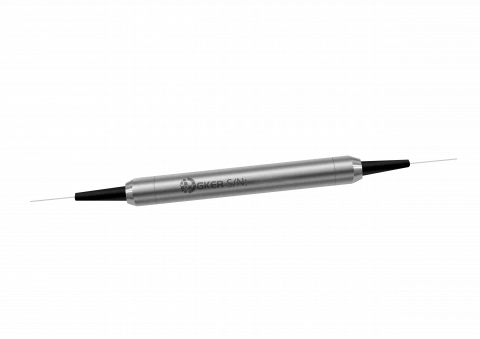1550nm RC Fiber Polarization Insensitive Isolator
For pricing, technical or any other questions please contact the supplier
- No registration required
- No markups, no fees
- Direct contact with supplier
-
Ships from:
China
-
Sold by:
-
On FindLight:
since 2024
Description
The RC Fiber Polarization Insensitive Isolator, part of the RCI Series, represents a pinnacle of engineering excellence, meticulously crafted to adhere to Telcordia standards. Employing an ingenious manufacturing process and an epoxy-free optical path design, this isolator showcases unparalleled power handling capabilities, making it an indispensable component in the realm of optical communication systems.
Beyond its technical prowess, it stands out for its reliability, high performance, and cost-effectiveness, embodying the perfect blend of innovation and practicality. With Grade A and Grade P options available, users can tailor its performance characteristics to suit their specific requirements, ensuring optimal outcomes in diverse optical applications.
1550nm RC Fiber Polarization Insensitive Isolator
Specifications |
|
|---|---|
| Type Of The Device: | Isolator |
| Operating Wavelength: | 1550 nm |
| Max Power: | 0.3 W |
| Min Isolation: | 28 dB |
| Center Wavelength (λc): | 1550 nm |
| Max. Optical Power (Continuous Wave): | 300 mW |
Features
- Telcordia Standard: Engineered and manufactured to meet Telcordia standards, ensuring quality and reliability
- Innovative Design: Features a unique manufacturing process and an epoxy-free optical path design for enhanced performance
- High Power Handling: Capable of handling high optical powers, making it suitable for demanding applications
- Excellent Performance: Delivers low insertion loss, high isolation, and superior return loss for optimal signal transmission
- Wide Application: Ideal for use in Erbium-Doped Fiber Amplifiers (EDFAs), Dense Wavelength Division Multiplexing (DWDM) systems, optical sensors, and compact optical circuits
- Back Reflection Suppression: Effectively suppresses back reflection and scattering, ensuring clean and reliable signal transmission
Applications
- Erbium-Doped Fiber Amplifiers (EDFAs): Enhances signal amplification in fiber optic networks, boosting signal strength for long-distance transmission
- Dense Wavelength Division Multiplexing (DWDM) Systems: Facilitates the multiplexing of multiple optical signals onto a single fiber, increasing network capacity and bandwidth
- Optical Sensors: Utilized in various sensing applications, including temperature sensing, strain sensing, and acoustic sensing
- Compact Optical Circuits: Integral component in the construction of compact and efficient optical circuits for telecommunications and data transmission
- Fiber Optic Communication Equipment: Essential for ensuring reliable signal transmission and minimizing signal degradation in fiber optic communication systems
Frequently Asked Questions
A polarization insensitive isolator is designed to allow light to pass through in one direction while blocking it in the reverse direction, regardless of the polarization state of the input light. This helps minimize back reflection and scattering in optical systems.
The RC Fiber Polarization Insensitive Isolator operates at a center wavelength of 1550 nm, which is commonly used in fiber optic communication systems.
The typical insertion loss of the isolator at room temperature (23 ℃) is 0.6 dB.
Yes, the isolator is capable of handling continuous wave optical powers of up to 40 mW, making it suitable for high-power applications.
The isolator is available in Grade A and Grade P options, offering different performance characteristics to suit specific application requirements.
Yes, the isolator can be configured with various connector types, including FC/UPC, FC/APC, SC/APC, and SC/UPC, providing flexibility for integration into different optical systems.
The isolator is compatible with RC SMF-28 fiber, which has a mode field diameter of 10.5 μm at 1550 nm.
The isolator can operate within a temperature range of -5 to +70 ℃, allowing for reliable performance in diverse environmental conditions.
The isolator should be stored within a temperature range of -40 to +85 ℃ to ensure its stability and longevity.
The isolator is widely used in Erbium-Doped Fiber Amplifiers (EDFAs), Dense Wavelength Division Multiplexing (DWDM) systems, optical sensors, and compact optical circuits to suppress back reflection and scattering, ensuring clean and reliable signal transmission.

